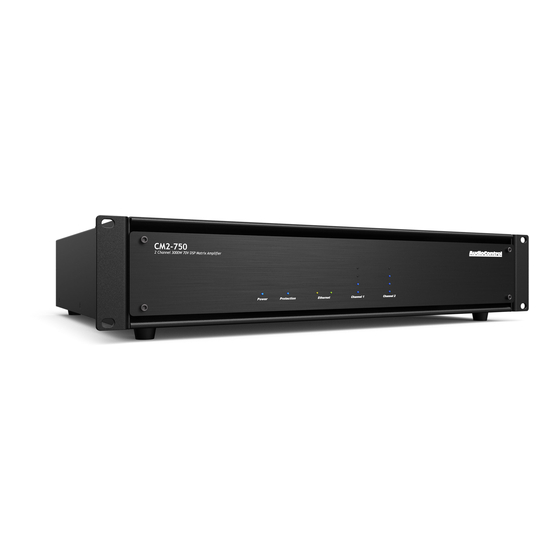Summarization of Contents
Important Safety Instructions
Safety Guidelines and Precautions
Essential safety instructions for operating AudioControl CM Series amplifiers, covering usage, cleaning, and ventilation.
Introduction
Product Features Overview
An overview of the AudioControl CM Series amplifiers, highlighting their unique features and design philosophy.
Quick View
Front Panel Quick View
Identifies and describes the LEDs and controls on the front panel of the CM Series amplifiers.
Rear Panel Quick View
Identifies and describes the input/output connectors and controls on the rear panel of the CM Series amplifiers.
Getting Started
Installation Examples Guide
Introduces typical installation scenarios for CM Series amplifiers, including mixed impedance and Dante systems.
Installation Examples
CM2-750 Installation Scenarios
Illustrates various connection setups for the CM2-750 amplifier, including 70V speakers and subwoofers.
CM3-750 Installation Scenarios
Demonstrates typical wiring configurations for the CM3-750 amplifier with 70V speakers and subwoofers.
CM4-750 Installation Scenarios
Shows common installation diagrams for the CM4-750 amplifier with 70V speakers and subwoofers.
Advanced CM4-750 Dante Installation
Details an advanced setup for the CM4-750 amplifier using an optional Dante card and network connections.
CM Series Rear Panel Comparison
Highlights the specific rear panel differences between the CM2-750, CM3-750, and CM4-750 models.
Front Panel Features
Front Panel Component Descriptions
Provides detailed explanations for each component and indicator located on the front panel of the amplifiers.
Rear Panel Features
Rear Panel Component Descriptions
Offers detailed descriptions of all connectors, switches, and indicators found on the rear panel.
Speaker Connection Guide
Explains how to properly connect speakers to the amplifier outputs, including mode switch settings and polarity.
Speaker and Wiring Impedance
Calculating Speaker Impedance
Guides users on how to calculate the total impedance when wiring multiple speakers in parallel.
Speaker Wire Resistance Guide
Provides a table illustrating the resistance of various wire gauges over different run lengths.
12 Volt Trigger Ins and Outs
Trigger Functionality and Methods
Details the various methods for controlling the amplifier's power state using 12V triggers and contact closures.
Ventilation
Ventilation Requirements and Best Practices
Outlines necessary airflow and spacing requirements for optimal cooling and performance of the amplifiers.
Internet Connectivity and Control
Network Setup and Browser Access
Explains how to connect the amplifier to a network and access its web interface for configuration and control.
Control via Telnet Commands
Telnet Command Usage and Examples
Describes how to use Telnet commands for automation and control of the CM Series amplifiers.
Set up via the Web Page
Web Interface Navigation and Settings
Guides users through navigating the amplifier's web interface to configure global and zone-specific settings.
Zone Settings
Zone Parameter Configuration Details
Explains the various parameters for configuring individual audio zones, including standby, name, volume, and input selection.
Zone Options
Speaker and Crossover Filter Settings
Details how to select speaker profiles and configure crossover filters (high pass, low pass) for optimized audio output.
EQ and Audio Adjustments
Covers the use of graphic and parametric equalization, as well as stereo/mono settings for fine-tuning audio performance.
Global Settings
Amplifier and Dante Configuration
Covers renaming the unit, setting signal sense, system locking, and configuring Dante network integration.
Input Sources Management
Explains how to manage and rename input sources, including Dante inputs, for flexible audio routing.
Network and Signal Settings
Details network configuration, including IP address, subnet mask, gateway, and SDS signal detection settings.
Notifications and Firmware Updates
Describes how to set up system alerts, manage settings files, and update the amplifier's firmware.
Benefits of Equalization
Equalizing the System Procedure
Provides a step-by-step guide on how to properly equalize the audio system for optimal sound reproduction.
Subsonic and Tweeter Protection Filters
Preset Configurations
Explains the use of preset memories for saving and recalling equalization and filter settings for different audio zones.
Advanced Discussions
In-Wall Volume Control Considerations
Discusses the impact of amplifier power on in-wall volume controls and recommends appropriate usage.
Multi-Unit Installation and Triggering
Addresses stacking limitations, daisy-chaining audio, and power trigger connections for multiple units.
Power Requirements and Circuit Loading
Explains power consumption, BTU output, and recommendations for circuit breaker usage for multiple amplifiers.
Trim Control and Room SPL
Discusses the use of trim controls for minor adjustments and considerations for achieving desired SPL in various room types.
Troubleshooting
Common Troubleshooting Scenarios
Provides solutions for common issues such as no sound, protection LED errors, and audio cutting out.
Service
Service and Repair Procedures
Outlines the process for obtaining service and repair for AudioControl products, including return instructions.
The Warranty
Warranty Conditions and Coverage
Details the terms, conditions, and duration of the AudioControl product warranty, including registration requirements.


















Need help?
Do you have a question about the CM2-750 and is the answer not in the manual?
Questions and answers